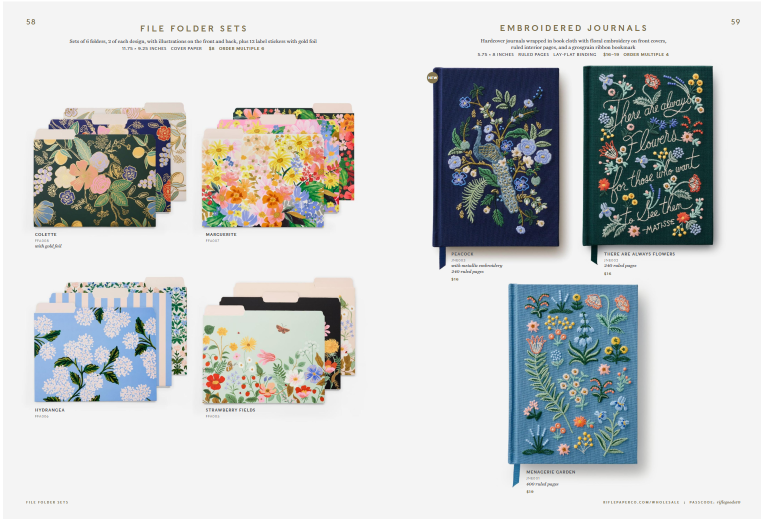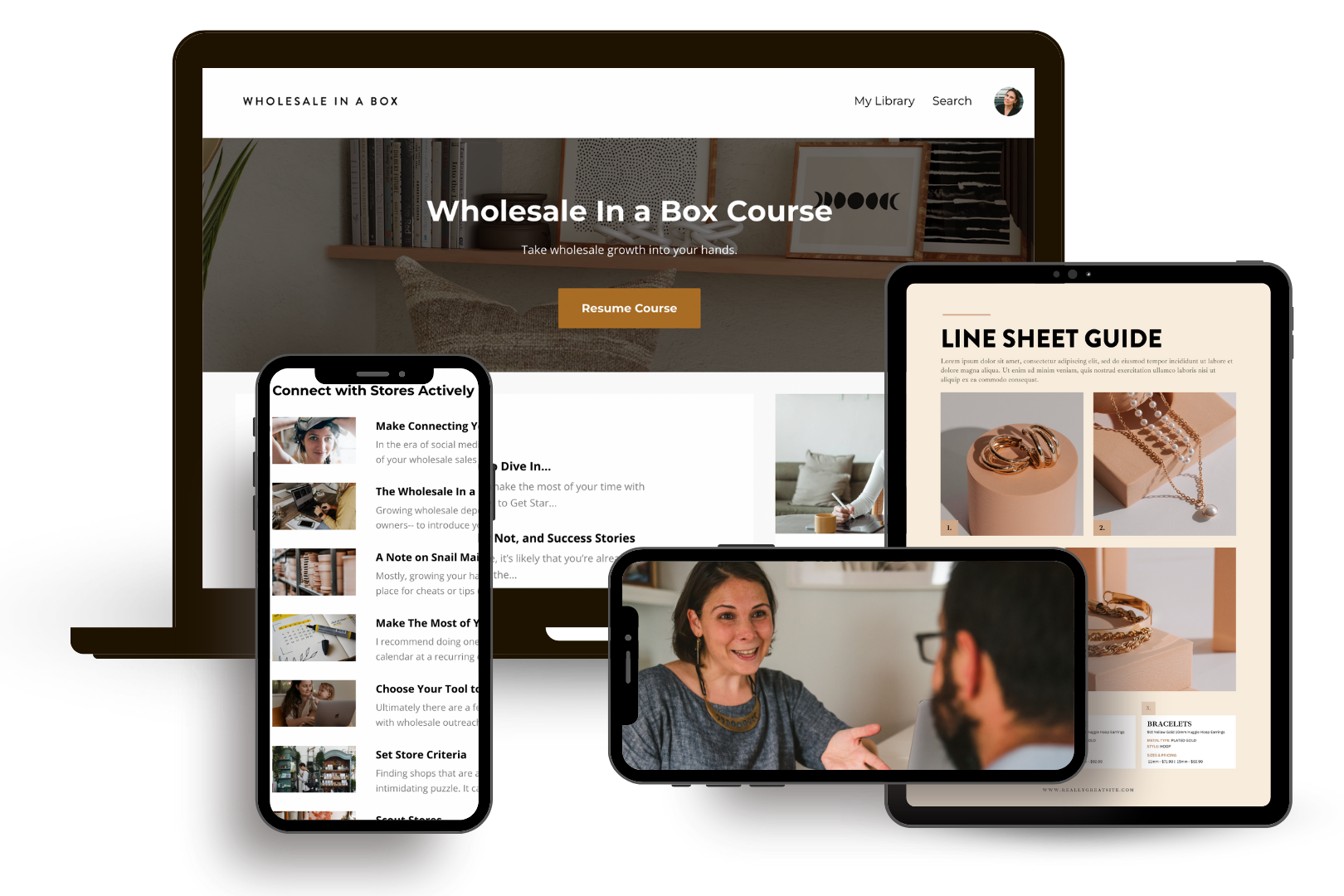Wholesale Line Sheet 101 Guide
Updated October 2024
If you're working to grow wholesale as a maker, fledgling product company, or independent brand, your line sheet is a crucial document. In fact, it's often going to be the only representation of your products that a store owner sees before they decide whether to place an order.
This Guide Will Help You:
Get clear on what a line sheet is and whether you need one.
Understand the difference between different line sheet types and platforms.
Outline a strong, effective structure for your line sheet.
Take simple steps to make an outstanding wholesale line sheet.
Avoid common mistakes and pitfalls.
Assess if your line sheet is good enough to start connecting with stores.
Who We Are
At Wholesale In a Box, we’ve worked with 1,500+ indie brands to help them grow wholesale. So we’ve seen the good, the bad, and the ugly of wholesale line sheets. If you want to put your best foot forward and get your products on shelves, it’s important that you have a great representation of what you do. To do that, there are some key things you need to know — and that’s what we’re tackling here.
What Is a Wholesale Line Sheet?
A line sheet is a document that a product brand creates so that store owners can review their products, prices, and wholesale terms – hopefully leading to an order.
The back story on line sheets: Traditionally, small brands grew wholesale primarily by going to trade shows. In that context, your line sheet had a single purpose -- it was the rundown/reminder of your products that store owners would take with them after visiting your booth so that they could review your line in greater detail and place an order. These line sheets weren’t anything fancy, but they were mandatory to have -- a list of products, unit numbers, prices, and terms, sometimes with small photos of each item. So when many people say “line sheet”, this is what they mean: a bare bones document with the key facts about your wholesale line.
Over the past couple of decades, the world of wholesale has changed dramatically. Trade shows have gotten more expensive and less reliable, especially for smaller or less established brands. Online marketplaces have become a near necessity for brands and makers growing wholesale. And direct outreach to stores (via email or snail mail) has proven to be an important part of a diversified strategy.
In this new world of wholesale, your line sheet may be your sole chance to present your brand and products to stores -- since the majority of the time, the store owner has not seen your products in person (like at a trade show booth.)
Given this, many small brands choose to create a document that is more of a hybrid between a lookbook/catalog and a traditional line sheet. It needs to show your products at their best, tell your story, give a rundown of items and prices, and explain your wholesale terms.
When You Need a Line Sheet
If you are a product brand or maker who wants to sell to stores, you likely need some kind of line sheet. In the very early days, it is possible to squeak by just showing your retail website to stores – but usually it’s worth the time to create a specialized document or online presentation of your products.
The Best Format For Your Line Sheet
The purpose of a line sheet is to present your wholesale product line to stores. And so although “line sheet” meant something very specifically traditionally – when we talk about a “line sheet”, we are talking more generally about a document or online platform that presents your wholesale products, prices, and terms to stores. Given that, there are a few different options in terms of format:
PDF Catalog / Line Sheet. A PDF line sheet can be a very effective way of sharing your products with stores, because you can control every aspect of the structure, layout, visual language, and story. It lets you craft a narrative about your products that is just for store owners.
Wholesale Marketplace Shop. Some makers use Faire or another marketplace as the place they showcase their products. This can work well if the vast majority of your sales come through that marketplace and that is your strategy moving forward as well.
Online Wholesale Storefront Tool. Online “storefront” and ordering tools like Candid or Brandboom can be a streamlined way to present your products and take orders. That said, sometimes it’s harder to control the way your story comes across and the monthly fees can be significant.
Wholesale Website. Some makers have a dedicated wholesale website. If you go this route, Shopify is a good option. For some some great Shopify tips and tricks check out The Best Tips on Using Shopify For Wholesale — From a Shopify Pro. That said, we’ve found that making a distinct wholesale website tends to make the most sense once you are selling to 100+ stockists.
Line Sheet Examples from Rifle Paper Co.
The Difference Between a Line Sheet, a Catalog, a Lookbook, and a Sell Sheet
The somewhat annoying truth is that, while there are differences among these documents, people mean different things when they use these words, so there is not exactly a hard-and-fast definition of each. That said, here are some broad differences:
Catalog. The fullest representation of your line, with full product listings, pricing, wholesale terms, as well as full color photos and lifestyle/model photos.
Lookbook. A multi-page overview of the ethos and aesthetic of the line. Usually focuses on model or lifestyle photos and usually does not include prices or individual product listings.
Line Sheet. A document that presents your products, pricing, ordering information, and wholesale terms. As we described above, this is traditional a more cut-and-dried document (similar to a spreadsheet, sometimes with photos) but should usually be more like a catalog these days.
Sell Sheet. A one-page document (think: an ad or a flyer). It gives an overview of your line in an attractive, scannable way.
Most indie product brands with less than 200 stockists will only need an excellent line sheet and can skip the other documents.
What Tool to Use to Create Your Line Sheet
If you’re creating a PDF line sheet, you should likely use one of two tools to create it:
Canva
✔ Free
✔ Easy to learn and use
✔ Professional look
✔ Our Line Sheet Template Tool uses Canva
✘ Limited layout flexibility
✘ Harder to update / change
InDesign
✔ Limitless layout options
✔ Professional look
✔ Good for long documents
✘ Costs monthly fee
✘ Harder to learn to use
Our Pick: If you already know InDesign or are savvy with tech tools, and have a subscription or don't mind paying for it, use that. If want a great result and don’t already know InDesign, use Canva. Only use Pages / Word or other layout tools as a last resort.
👋 Looking For a Line Sheet Template?
Click here to get one for free. It’s part of Line Sheet In An Afternoon — our minicourse that gives you a 39-page comprehensive line sheet template to mix, match, and modify — along with the guidance, motivation, and help you need to make a great line sheet fast.
Basic Line Sheet Sections and Structure
Front Cover
With a compelling picture or two, your logo / brand name, title and date range (e.g., Brand Name Fall/Winter 2023-24 Wholesale Line sheet) and complete contact information. This is the first introduction of the line, so spend a bit of time to make sure the photo and overall look represent you well. We’ve got an entire article just for the Wholesale Line Sheet Cover Page here.
About Page
Include a brief description of you and your products plus a couple of process or studio pictures. This is your chance to tell your story, and the story of what makes your products unique. If you don't have any great photos of you, it can be worthwhile to take a few hours in a spot with good natural light and get a snapshot or two that you can use.
Product Pages
You usually want 4-6 products per page, grouped by type. Make sure that the pictures of the products are very clear and representative of what it is, and that for each product, you include 1-2 photos, the product name, unit number (if you have them), MSRP, wholesale price, and any variants available (like if it's available in multiple colors).
Wholesale Terms
Then, add a page that includes ordering instructions, policies, and terms. It should also have contact information. You'll want to be sure to cover minimums, turnaround time, payment forms, how to order, who covers shipping and/or insurance, etc. You can find more details on this in the "Other Tips" section, below.
Order Form (Optional)
You can choose to include or not include an order form. It should include contact information if you do. Whether or not you need one depends a bit on the profile of the store you're approaching -- do you think "your" store owners will tend to be more traditional or more modern in their approach?
Back Cover
Then, close with a "back cover" with a final picture and contact information. You can also consider having a footer on each page with your contact info -- the idea being to make it very easy for a store to order at any point.
Example Product Photo from Moore Collection
Wholesale Terms page from Rifle Paper Co.
9 Steps to Create Your Wholesale Line Sheet
Not sure where to start? Consider using the following step-by-step process as you create your new line sheet.
Set a deadline.
This is the kind of project that can expand to fit whatever amount of space you give it. Somewhere between 2 and 7 days is probably about right -- we don't recommend letting it slip to longer than that, as it can turn into the Line Sheet That Never Ends.Make a list or map of your products.
Think about which products you're wholesaling and make sure you have prices for each. Consider how you'd like to group them as well.Choose your line sheet layout program.
See above for our comparison!Review your photos.
Your line sheet will only be as good as your product photos. If you're missing photos or some are sub-par, plan a half-day photo shoot to get or replace the photos.Draw out your line sheet on actual paper.
This is called wireframing, as you probably know. It allows you to make the main decisions first, rather than worrying too much about things like detailsPut together the rough structure in the line sheet layout program.
It usually works best to get the overall structure (pages, sections, headlines) laid out first so you don't get stuck on minutiae.Go back through and add in product details.
Now, add in individual photos, SKU numbers, descriptions, pricing, and your content/text throughout.Refine visual language.
Check for colors, fonts, font size -- and make sure that all of your "visual language" is working together and is aligned with your brand.Compress.
You want your line sheet to be 2-5 MB if you're attaching it to emails. If you're hosting it online, it can be bigger. But if you're attaching and it's too big, consider using smallpdf.com to reduce.
👋 Looking For a Line Sheet Template?
Click here to get one for free. It’s part of Line Sheet In An Afternoon — our minicourse that gives you a 39-page comprehensive line sheet template to mix, match, and modify — along with the guidance, motivation, and help you need to make a great line sheet fast.
Frequently Asked Questions About Wholesale Line Sheets
Q. How much does design matter in my line sheet?
A. A great product can overcome a badly designed line sheet… but why work against yourself? Here are some good design practices to keep in mind:
Visual hierarchy: the darker and larger you make things, the more attention they will call from the viewer. So try to keep the most important things most attention-grabbing. More here.
Don’t use too many fonts or colors so that the products are the star.
Eliminate anything that’s not on-brand.
You may want to hire a designer to make it all look cohesive, professional, and brand aligned. Alternatively, you may need to “hire yourself” as a designer, coming in after you've gotten some distance from the document and really giving it the once-over.
Q. How long should my line sheet be?
A. Most makers will end up with a 5-15 page document. If yours is longer, but it's beautiful and readable, you're good to go -- within reason! If your line sheet is 50 or 100 pages, you might want to think about how to make it more manageable or adding a very strong Table of Contents. If you’re printing your line sheet, you’ll obviously need to worry more about length.
Q. To send my line sheet to store owners, should I host it somewhere or just attach it to an email?
A. Different makers choose different approaches. If you have a Gmail account, it works quite well to host it there and link to it in your email. Attaching it to your email can also work – just make sure it's less than 2-5 MB in total size so as not to inadvertently get deleted by clogging inboxes. Our one caveat is to be sure to not create a confusing or time-consuming access or login structure.
Q. Should my line sheet be publicly accessible?
A. We find that it's important for store owners to have everything they need to make a decision on your line, as soon as you contact them. For that reason, I don't recommend forcing them to create a wholesale account or login before viewing the line sheet. If you have your line sheet online, you can create a simple password that you share in your initial outreach email. Or, it can technically be publicly accessible as long as it's not in the obvious path of retail customers.
Q. How do I know when my line sheet is good enough?
A. Acknowledge your tendencies. If you're a perfectionist who fusses over the smallest detail and makes sure everything is 10,001% perfect before it leaves your sight, acknowledge that tendency. My perfectionist friends may want to use a light touch with their line sheet, setting a strict deadline and not fretting over the details. On the other hand, if you know that you're great at the big picture but skip the details and design flourishes, acknowledge that tendency. My "big picture" friends may want to sit with this project a bit longer than usual, locking in a strong design. The truth is that our most successful makers use an approach to line sheets that is somewhere between the perfectionist approach and the laissez-faire approach -- so try to push yourself a bit in the direction that may not come as naturally.
Q. What if I want to do things in a different way or got different advice from a trusted guide?
A. Trust your instincts. We've tried to make this guide as clear and concrete as possible, since we know makers have enough to worry about, without having to guess about what their line sheet should look like. And, we have based it on what we've seen to be most effective in working with 1500+ makers. That said, I truly believe that you know what is best for you, for your vision, and for your company. So please, do trust your instincts and disregard anything in this guide that doesn't serve you.
How We Can Help You Grow Wholesale:
Wholesale In a Box
Our beloved comprehensive course and coaching is your all-in-one way to grow wholesale fast, steady, and long-term. Learn more here.
Line Sheet In An Afternoon
Our minicourse that gives you a 39-page comprehensive line sheet template to mix, match, and modify — along with the guidance and help you need to make a great line sheet fast. Sign up here.
Getting Started With Wholesale
A free 4-part email course covering the basics of how wholesale works, keys for success, whether it’s right for you, and how to get started. Sign up here.











